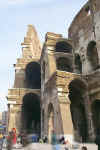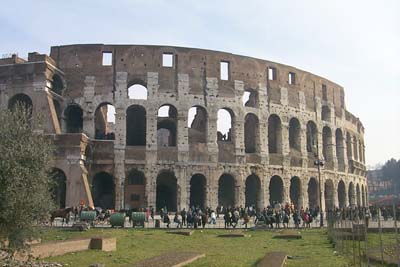-
- It took only eight years to erect
the greatest monument of ancient Rome. Its original name is Flavian
Amphitheatre, because of the form of the construction as an
amphitheatre and because it was built by emperors of the Flavian
dynasty: Vespasian, Titus and Domitian. Vespasian begun it in
72 A.D., Titus completed the works in 80 A.D. and Domitian added the
higher steps and some service zones beneath the arena. The inaugural
festival lasted 100 days, during which many gladiators and 5000 wild
beasts were killed.
- The popular name "Colosseo"
or "Colosseum" was first mentioned in the 7th century in
the writings of the venerable Bede, who quotes a prophecy of
Anglo-Saxon pilgrims: "Quamdiu stabit Colyseus stabit et Roma;
quamdiu cadet Colyseus cadet et Roma; quamdiu cadet Roma cadet et
mondus", i.e. "Till the Colosseum stands the Rome will
stand; when the Colosseum falls the Rome shell fall; when Rome falls
the world shall fall".
- The name "Colosseum"
derived from a colossal statue of emperor Nero (35m high) with the
head in form of the Sun, which stood in the square in front of the
Amphitheatre.
- Together with the 7m high basement
the statue reached the height of the amphitheatre, and it was the
largest bronze statue ever made, even larger than its model, the
Colossus of Rhodes. It was moved here from the vestibule of the
Domus Aurea of Nero on the Roman Forum by Hadrian when he built on
its side the Temple of Venus and Rome. There were 24 elephants used
to shift it.
- The project of the construction
belonged to an architect of the imperial family Quintus Aterius. Its
basement is located in a natural cave formerly occupied by water and
named the lake of Domus Aurea. The lower part of the amphitheatre
could be used already after four years. From outside it looked like
an enormous ring with four storeys entirely made of travertine. The
first three storeys included 80 archways with the Doric columns on
the ground floor, Ionic on the 2nd floor and Corinthian on the 3rd
floor. The 4th floor was in form of a wall with the rectangular
windows and corbels destined to support 240 piles holding a huge
velarium served to protect the spectators from the sun or rain. The
Colosseum stands on a 13 meters high concrete platform, which is
thought to be the secret of the resistance of the amphitheatre to
the time, earthquakes (in 422, 1231 and 1349) and other possible
damages.
-

- Dimensions: 188m x 156m, the
circumference in 527m, the height from outside is 50m. Construction
was made of 100,000 cubic meters of selected travertine (from the
cave of Acque Albule under Tivoli) and 300 tuns of metal served to
keep together the blocks with the iron tenons (these were torn out
in the Middle Ages and their sockets are visible). Its capacity was
70,000 spectators. Gladiatorial combats were suppressed in 407 and
fights with wild beasts in 523.
- The performances were free. There
were 80 entrances that supplied the quick entrance and exit of the
people. All of them were numbered except the four main entrances.
Each spectator entered by the arch corresponding to the number of
his ticket.
- Interior was divided into three
parts: the arena, the podium and the cavea. The
arena measures 76m by 46m. Its name
comes from the sand (arena) which covered the floor in order to
prevent combatants from slipping and to absorb the blood. The
subterranean passages were used for the arrangement of the
spectacles, and provided space for the mechanism by which scenary
and other apparatus were hoisted into the arena. There were also
cages for animals and rooms of gladiators. The arena was surrounded
by 5m high wall to protect the spectators from the animals. At the
top of it was a podium, i.e. a broad
parapeted terrace in front of the tiers of seats, on which was the
imperial couch and places for senators, pontiffs, vestals, foreign
ambassadors. The cavea
was divided into three tiers: the lower one was reserved for knights,
the middle one for the wealthier citizens, and the top one for the
populace. The steps on which the spectators were sitting were made
of bricks, except those of the emperor and nobility that were marble.
Above the topmost tier was a colonnade, to which women were admitted.
At the very top was the narrow platform for the team of sailors from
Misenus, who were responsible for the velarium (awning).
- According to a legend Colosseum was
a place of martyrdom of numerous Christians, but it was never proved
by historical documents.
- During the Middle Ages the Colosseum
was adapted for the fortress of the Frangipane, and later of
Annibaldi, till the emperor Henry VII didn't present it to the Roman
people in 1312. Until 1743, when Benedict XIV consecrated Colosseum
to the cult of martyrs and built inside a little church of S.Maria
della Pieta', it was endless source of the building material for the
other monuments.
- Important works of consolidation
were undertaken by the popes of the first half of the 19th century.
When Rome became the capital of Italy the Colosseum was cleaned from
the vegetation which covered it, isolated from the overbuilt and
adjoining constructions, and was profoundly studied, eliminating the
arena.
-
- On the site where the Via Sacra and
Via di S.Gregorio meet were located "meta sudante", a
fountain, and a statue of Nero. The ruins of these two monuments
were demolished by fascists in 1934 as they were the obstacles for
the parades performed here.
|

